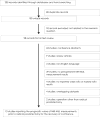Preoperative Membranous Urethral Length Measurement and Continence Recovery Following Radical Prostatectomy: A Systematic Review and Meta-analysis
- PMID: 27394644
- PMCID: PMC5600894
- DOI: 10.1016/j.eururo.2016.06.023
Preoperative Membranous Urethral Length Measurement and Continence Recovery Following Radical Prostatectomy: A Systematic Review and Meta-analysis
Abstract
Context: Membranous urethral length (MUL) measured prior to radical prostatectomy (RP) has been identified as a factor that is associated with the recovery of continence following surgery.
Objective: To undertake a systematic review and meta-analysis of all studies reporting the effect of MUL on the recovery of continence following RP.
Evidence acquisition: A comprehensive search of PubMed, EMBASE, and Scopus databases up to September 2015 was performed. Thirteen studies comprising one randomized controlled trial and 12 cohort studies were selected for inclusion.
Evidence synthesis: Four studies (1738 patients) that reported hazard ratio results. Every extra millimeter (mm) of MUL was associated with a faster return to continence (hazard ratio: 1.05; 95% confidence interval [CI]: 1.02-1.08, p<0.001). Eleven studies (6993 patients) reported the OR (OR) for the return to continence at one or more postoperative time points. MUL had a significant positive effect on continence recovery at 3 mo (OR: 1.08, 95% CI: 1.03-1.14, p=0.004), 6 mo (OR: 1.12, 95% CI: 1.09-1.15, p<0.0001). and 12 mo (OR: 1.12, 95% CI: 1.03-1.22, p=0.006) following surgery. After adjusting for repeated measurements over time and studies with overlapping data, all OR data combined indicated that every extra millimeter of MUL was associated with significantly greater odds for return to continence (OR: 1.09, 95% CI: 1.05-1.15, p<0.001).
Conclusions: A greater preoperative MUL is significantly and positively associated with a return to continence in men following RP. Magnetic resonance imaging measurement of MUL is recommended prior to RP.
Patient summary: We examined the effect that the length of a section of the urethra (called the membranous urethra) had on the recovery of continence after radical prostatectomy surgery. Our results indicate that measuring the length of the membranous urethra via magnetic resonance imaging before surgery may be useful to predict a longer period of urinary incontinence after surgery, or to explain a delay in achieving continence after surgery.
Keywords: Magnetic resonance imaging; Membranous urethra; Membranous urethral length; Meta-analysis; Prostate cancer; Systematic review; Urinary incontinence.
Copyright © 2016 European Association of Urology. Published by Elsevier B.V. All rights reserved.
Conflict of interest statement
Figures







Comment in
-
Magnetic Resonance Imaging for Membranous Urethral Length Assessment Prior to Radical Prostatectomy: Can it Really Improve Prostate Cancer Management?Eur Urol. 2017 Mar;71(3):379-380. doi: 10.1016/j.eururo.2016.11.011. Epub 2016 Nov 22. Eur Urol. 2017. PMID: 27887943 No abstract available.
References
-
- Patel VR, Abdul-Muhsin HM, Schatloff O, et al. Critical review of “pentafecta” outcomes after robot-assisted laparoscopic prostatectomy in high-volume centres. BJU Int. 2011;108:1007–17. - PubMed
-
- Punnen S, Cowan JE, Chan JM, Carroll PR, Cooperberg MR. Long-term health-related quality of life after primary treatment for localized prostate cancer: Results from the CaPSURE registry. Eur Urol. 2015;68:600–8. - PubMed
-
- Liss MA, Osann K, Canvasser N, et al. Continence definition after radical prostatectomy using urinary quality of life: Evaluation of patient reported validated questionnaires. J Urol. 2010;183:1464–8. - PubMed
-
- Sanda MG, Dunn RL, Michalski J, et al. Quality of life and satisfaction with outcome among prostate-cancer survivors. N Engl J Med. 2008;358:1250–61. - PubMed
-
- Holm HV, Fossa SD, Hedlund H, Schultz A, Dahl AA. How should continence and incontinence after radical prostatectomy be evaluated? A prospective study of patient ratings and changes with time. J Urol. 2014;192:1155–61. - PubMed
Publication types
MeSH terms
Grants and funding
LinkOut - more resources
Full Text Sources
Other Literature Sources
Medical

